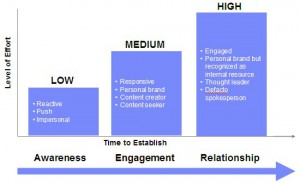Over the last few years I’ve been working with colleagues across my company to provide them guidance on becoming more effective with sharing their domain knowledge through social networking and collaboration. Many Subject Matter Experts (SMEs) I’ve worked with often ask me “What characteristics are common amongst those that are the most effective and influential?” The following is a collection of my observations as well as some suggestions from my work enabling the social workforce.
Be true to yourself
Always be true to yourself when you engage in social activities. When establishing a social presence it should be an expression of who you are and what you want to share with others about what you know. Consistently present yourself, using the same tone, in every interaction and communication. Know yourself and be authentic. Be Genuine. Be Real. Be yourself – only you can do that!
Putting yourself out there
I find that the SMEs who become known are those that are comfortable collaborating, commenting, and publishing in social environments in a sustained and highly engaged way. You should assess your comfort level with establishing a public persona. By nature, being active on social means you are putting yourself out in public. When doing so, being honest about who you are and what you know is critical. You need to be comfortable and have a willingness to share your name, your thoughts, opinions, and recommendations to help others who seek your domain expertise. Doing so will help build your character and establish credibility. As you think this through, know your limitations. If you are not comfortable with sharing your knowledge and expertise in such a public forum, you should recognize and respect that.
What are your goals? What do you want to accomplish?
Are you looking to monitor competitors, connect more closely with your customers, or to establish yourself as a prominent thought leader in a particular area? Think about your goals and what you want to accomplish before you get started. Establishing goals will help you to be true to yourself, know your limitations or obstacles as well as provide you context for which tools and venues you should consider as best fit to match your intentions.
Know your audience
Successful SMEs listen to their audience and are willing to leverage listening tools to gather social intelligence and identify the existing social graphs of those they most want to connect with. Consider enhancing your online professional network by:
– Studying your target audiences wants and needs
– What questions are they most commonly asking?
– What issues/problems are they looking to solve?
– Understand the knowledge sought – do you have something of value to offer? Knowing what is happening TODAY in product or technology vertical is critical
Gather social intelligence to better understand the social ecosystem
– Pay attention to where they most often participating on-line
– Which venues? Which communities? Which forums?
– Who are they connected to?
– Who are they influenced by?
– Are you connected with them? If not, why not? Perhaps you should be
Know the rules for engagement
If you are sharing your professional knowledge about a brand or product, you should be sure that you understand the way that topic, brand or product should be represented.
– How should the technology, product or brand be referenced?
– Understand the messaging
– Understand the keywords and natural language your audience uses to discuss the topic, brand or product
– Understand what is OK or NOT OK to share
– What digital assets are available for you to share which would help you help your audience further understand?
Only the passionate survive!
Those that have deep subject matter expertise to share and are passionate believers that knowledge they possess is of interest and will benefit the community they intend to share it with, are the most successful at building a degree of influence. They are relationship builders at heart, who are comfortable with and find value in creating relationships digitally. Successful SMEs are on a quest to make connections and deepen relationships with those who are seeking and understanding of the topic that they are passionate about.
Commitment to sustained engagement
A key trait of successful SMEs is commitment. They strive to sustain engagement long term, while growing and evolving their participation over time to achieve personal and business objectives. They understand that it takes time to build credibility, trust and a degree of influence. They understand that it requires a long-term strategy.
Inquiring minds want to know
Curious by nature engaged SMEs don’t pretend to have all the answers. They know that ambiguity breads commentary and feedback. They often leave the last word to their audience. Doing so allows them to learn more about their audiences needs. It also provides them a way to be responsive to the topic/discussion in a more engaged and relevant way.
Karma
Successful SMEs understand the basic premise of cause and effect, what goes around comes around. They strive to serve the needs of others while receiving insights for themselves. They know that what they publish is permanent and can not be taken back. Remember, if you publish something inappropriate, embarrassing, or hurtful, there will be a record for years to come.
Do you have ideas to share on guiding and enabling SMEs? I’d love to hear them.


